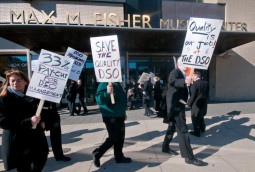 “The region’s cultural hub, Portland has a striking art museum housing three centuries of art and architecture and a world-class permanent collection, performing arts centers, active historical and preservation groups, an art school and a university, a symphony orchestra, numerous galleries, coffeehouses, and enough activities to keep culture vultures busy well into the night, especially in the thriving, handsomely restored Old Port and the up-and-coming Arts District.” Coastal Maine. Moon Handbooks.
“The region’s cultural hub, Portland has a striking art museum housing three centuries of art and architecture and a world-class permanent collection, performing arts centers, active historical and preservation groups, an art school and a university, a symphony orchestra, numerous galleries, coffeehouses, and enough activities to keep culture vultures busy well into the night, especially in the thriving, handsomely restored Old Port and the up-and-coming Arts District.” Coastal Maine. Moon Handbooks.
The Waters of Rome, Katherine Rinne’s recent book on the revitalization of Rome in the 16th Century, sees the city’s reuse of the disused aqueducts as crucial to its rebirth during and after the Council of Trent. Rome’s hydrological history is necessarily intertwined with its political history because without water there is no life; whoever gained access to water as it poured into and through the city via the ancient underground system became part of the chain of power that affected political life above ground. If water was among the cards in your hand, you would certainly be welcome as a power player at the gaming table. For a Duke or a Bishop. gaining access to water required considerable diplomatic skill, but the payoffs from those further down the hierarchical ladder were substantial.
In contrast, rather than as an infrastructural element, the Cultural Arts are regarded as a superstructural component of American life, adding to the surface but not contributing to the foundational solidity of society. They are a worthy addition and great for the tourists, but of little substantive bedrock benefit to the local citizenry.
 Controlling the supply of live Mendelssohn orchestral music by threatening and then executing strike action creates no frenzied panic, as the Detroit Symphony Orchestra musicians have discovered to their detriment. It didn’t help that the DSO’s management overpaid themselves and perhaps criminally mishandled the company finances, leading to the organization’s financial ruin, but then for the musicians to respond by withholding their musical services exposes a comical clash of understanding. In the eyes of the public, to withhold an inessential service is a bewilderingly futile gesture, (‘Manicurists OUT!’ ‘Pet Psychiatrists UNITE!’) that points out the decorative nature of the job in the first place. The musicians have imperiled their own present and future employment, the existence of the organization itself, and also the credibility of their profession.
Controlling the supply of live Mendelssohn orchestral music by threatening and then executing strike action creates no frenzied panic, as the Detroit Symphony Orchestra musicians have discovered to their detriment. It didn’t help that the DSO’s management overpaid themselves and perhaps criminally mishandled the company finances, leading to the organization’s financial ruin, but then for the musicians to respond by withholding their musical services exposes a comical clash of understanding. In the eyes of the public, to withhold an inessential service is a bewilderingly futile gesture, (‘Manicurists OUT!’ ‘Pet Psychiatrists UNITE!’) that points out the decorative nature of the job in the first place. The musicians have imperiled their own present and future employment, the existence of the organization itself, and also the credibility of their profession.
Turning off a water supply gets everyone into the streets to get it turned back on again. Turning off an orchestra – what percentage of people noticed? Surely a better strategy would be to demonstrate the essential nature of your service to society, show what value you bring to the lives of citizens and schoolkids, get evangelizing!
The Arts are perceived as a superstructural element, not evenly spread across the landscape but rather deliberately concentrated in certain areas. Tourist guidebooks like to emphasize this phenomenon to attract the attention of the Wanderlusty. The Moon Handbook description of Portland, ME, envisions the Arts as an unevenly distributed presence throughout the state. Within Maine there is a concentration in Portland, presumably facilitated by the density of the urban environment. Inside Portland there are arts centers and museums, galleries and academic institutions that act as a magnet to the artistically inclined. And within Portland there is yet another layer, an Arts District, a centralized and newly refurbished localization of cultural facilities.
According to PortlandMaine.com “The world class Portland Museum of Art, the Children’s Museum of Maine, the Institute of Contemporary Art at the Maine College of Art, the Center for Cultural Exchange, the State Theater, the Portland Stage Company, the Center for Maine History, and the stunningly-renovated Merrill Auditorium all line Congress Street,” the spine of the Arts District.
Urban density facilitates the marketplace, and the greater the number of people the more viable the life of the market, the broader and more diverse the ideas passing through, the healthier the Capitalist organism. But Art and Capitalism are at fundamental odds with one another; Art is the unfettered expression of ideas, Capitalism chains everything to the dollar. If you can’t sell it, don’t paint it.
 Interestingly, the Moon Handbook expresses this unease rather handily by referring to the tourists who frequent the Arts District as ‘culture vultures’, a term that has entered the common lexicon without comment despite its derogatory meaning; a vulture tears the flesh off the dead or dying carcass of an animal, and alerts his friends to do the same, leaving behind nothing but bones and death. That Portland should want to be attractive to such carrion speaks volumes of the city’s self-image, and its need for the attention of such birds. And who are these ‘culture vultures’ whose lifestyle is so at odds with that of the locals and yet so necessary for the local economy that they are willing to stick out like sore thumbs, partying it up, drinking coffee into the small hours, flinging their money around at the local galleries in the Old Port, buying up all manner of marketable canvases. What a strange cultural landscape is here envisioned for Madam Portland, ME.
Interestingly, the Moon Handbook expresses this unease rather handily by referring to the tourists who frequent the Arts District as ‘culture vultures’, a term that has entered the common lexicon without comment despite its derogatory meaning; a vulture tears the flesh off the dead or dying carcass of an animal, and alerts his friends to do the same, leaving behind nothing but bones and death. That Portland should want to be attractive to such carrion speaks volumes of the city’s self-image, and its need for the attention of such birds. And who are these ‘culture vultures’ whose lifestyle is so at odds with that of the locals and yet so necessary for the local economy that they are willing to stick out like sore thumbs, partying it up, drinking coffee into the small hours, flinging their money around at the local galleries in the Old Port, buying up all manner of marketable canvases. What a strange cultural landscape is here envisioned for Madam Portland, ME.
